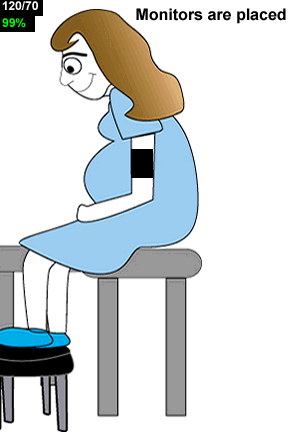Anesthesia for Cesarean Delivery
| Cesarean delivery is performed in about 1 in 5 births. The delivery may be planned (i.e. elective cesarean delivery), or an emergency (well-being of mother or baby is at risk). Anesthesia is necessary for cesarean delivery. A regional or a general anesthetic can be administered. The choice of anesthesia is determined by the clinical situation and by your medical condition. The role of your anesthesiologist is to ensure your comfort and safety. Is anesthesia safe for the baby? Both general and regional anesthesia are safe and have no significant effects on the baby. Obstetric anesthesiologists prefer to administer a regional anesthetic whenever possible as it minimizes airway (breathing) complications. It is a safe and effective anesthetic that allows you to be awake and pain free during the operation. During both regional and general anesthesia, safety monitors are applied to ensure that your vital signs are monitored and stay within the limits that are necessary for the well-being of the baby. Is it necessary to fast before Cesarean delivery? Before all elective surgeries, regardless of the type of anesthesia that is administered, fasting is necessary. (See “Can I drink or eat during childbirth”). Before the administration of either regional or general anesthesia, you will be given an antacid to drink. This is necessary to neutralize the acid in the stomach. This precaution may reduce the chance of lung injury in the event that there is regurgitation of stomach contents into the breathing passage. You may also be given anti-nausea medications through your vein. What happens if I just ate? In an elective situation, a time period of about 8 hours of fasting is necessary. The surgical procedure will be delayed. In an emergency situation, precautions are taken to minimize the risk of aspiration (regurgitation of stomach contents into the lungs). |
| Procedure of spinal anesthesia. Click on the 'play button' when you are ready. |
 |
| What is a regional anesthetic? Spinals, epidurals and combined spinal-epidurals are regional anesthetics. A section or “region” of the body is numbed by the medicine that is injected into the spinal canal. The legs, the torso and part of the chest are the areas that become numb. What’s the difference between a spinal and epidural and a combined spinal-epidural? The spinal cord and the nerves are contained in a sac of cerebrospinal fluid. The space around this sac is the epidural space (see section on 'Regional anesthesia'). Spinal anesthesia involves the injection of numbing medicine directly into the fluid sac. Epidurals involve the injection into the space outside the sac (epidural space). Spinals and epidurals have the same effect (i.e. numbs a large region of the body) because they both involve numbing of the nerves as they branch off the spinal cord. Since the spinal injection is more “direct”, the effect is immediate. Spinals are usually the first choice of anesthetic for women who are not in labor but need a Cesarean delivery. Epidural anesthesia takes a little longer to establish desired affect. Because a small tube (catheter) can easily be placed in the epidural space, repeated doses of medicine can be given to maintain anesthesia as long as needed. Epidurals are the primary way of relieving pain in women that request analgesia for labor. A combined spinal-epidural involves a spinal injection followed by the insertion of an epidural catheter. Quick onset can be achieved with the spinal part. Further maintenance of the anesthesia is achieved through the epidural catheter. How is a spinal anesthetic given? The procedure for spinal anesthesia is similar to epidural anesthesia for labor or for cesarean delivery (see picture). The difference is that medicine is injected directly into the spinal sac. A thin needle is used to reduce the chances of a spinal headache. How will I know if the spinal is working? Many women describe an immediate feeling of warmth and tingling in the feet which extends up the legs and torso as the spinal anesthetic takes effect. Your legs will then begin to feel numb and heavy. Although your ability to breathe is not changed, the spinal does numb the chest area as well, so the sensation of breathing will feel altered with a subjective sensation of feeling 'short of breath.' Although you are breathing adequately, your brain does not appreciate the movements of your chest due to chest numbness. As long as your hands are not weak and your are able to talk, be reassured that you are breathing adequately. In addition, you can sense moisture condensation on the mask during each breath. Moreover, you should always remember that the anesthesiologist is monitoring and watching your breathing, oxygen levels, blood pressure, heartbeat and other vital signs. After the spinal is placed, the anesthesiologist will check the level of anesthesia by assessing the extent of the numbness. It is normal for the body to feel numb from the lower chest down to the feet. This is considered the right amount of anesthesia to keep you comfortable for the operation. Can a labor epidural be used for Cesarean delivery? Some women who go through labor might eventually require a Cesarean delivery. This can be due to non-urgent factors (labor not progressing), or urgent factors (mother or baby’s condition is at risk). If an epidural catheter has been in place and functioning well, most of the time the anesthesiologist can put additional medicine into the catheter to make the numbness adequate for surgery. As with spinal anesthesia, it is normal for the body to feel numb from the lower chest down to the feet. Again, this is considered the right amount of anesthesia to keep you comfortable for the operation. If the epidural does not work, it may be replaced, or spinal or general anesthesia may be used. This choice depends on the urgency of the situation. This is, however, uncommon. Will I feel anything if I’m awake for the operation? With a spinal or epidural anesthetic, you should not feel any pain with the operation. Being awake, you will still be aware of movements occurring in your lower body. Specifically, you may sense a feeling of “pulling and tugging” as the obstetrician separates the abdominal muscles and tissues. In addition, at the time of delivery, the obstetrician will push down on your abdomen to facilitate the delivery of the baby. You will feel this sensation as pressure in your chest. |
